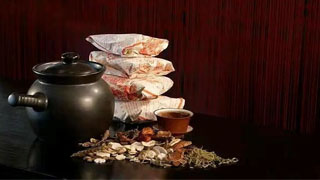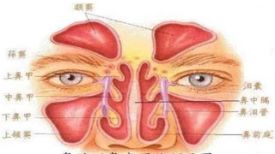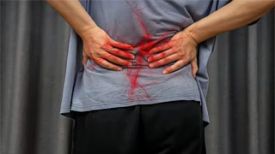
Do traditional Chinese medicine have formulas to enhance immunity? There are too many such formulas. However, immunity is a term in modern medicine, and traditional Chinese medicine does not use this term. It is called 'Zhengqi' in traditional Chinese medicine, and enhancing immunity means supporting the body.
Guizhi Tang is such a good prescription for strengthening the body and dispelling evil. It can nourish the righteous qi internally and drive out evil qi externally. There are neither internal nor external troubles, and it's a joyful and harmonious experience.
Zhang Zhongjing is the only one who can make the prescription so perfect.
Guizhi Tang comes from the "Treatise on Cold Damage" and is the first prescription that appears in the text of the "Treatise on Cold Damage". In addition, it is so easy to use that it is also known as the first prescription for cold damage in later generations.
Guizhi Tang formula: 9g Guizhi, 9g Raw Paeonia lactiflora, 6g Licorice, 9g Ginger, 4 Jujubes.
Thinking that this prescription existed thousands of years ago, I feel that traditional Chinese medicine is truly miraculous. Many of the formulas in the Treatise on Cold Damage are still in use today, and the treatment effect is still very good.
The original text of the Treatise on Cold Damage is, "When the sun blows, the yang floats and the yin weakens. When the yang floats, the heat is spontaneous; when the yin is weak, sweat comes out naturally. When it is too cold, the wind is too strong, and the nose is dry and nauseous, Guizhi Tang is the main treatment
I am a little afraid of cold, wind, and have a runny nose. I have a slight fever, dry nausea, and may sometimes sweat. Written very vividly, this is the type of cold that Guizhi Tang targets.
Traditional Chinese Medicine believes that there are two types of qi in a person: Wei Qi and Ying Qi. One is the "Wei Qi" that protects you, and the other is the "Ying Qi" that nourishes you. The "Wei Qi" is located outside the Ying Xing meridian. The term 'pulse' here does not refer to meridians, but to blood vessels.
The vital energy that flows along with blood in blood vessels is called vital energy; The life between the muscle folds and tissues outside the blood vessels can be called Wei Qi.
People with relatively weak skin pores have poor skin resistance when they are exposed to wind and cold, and when the wind blows, they cross the skin's defense.
Wind damages the defense ", when cold evil enters the body surface, it is necessary to organize the first line of defense and counterattack to eliminate the coldness on the body surface through sweating; Prevent cold pathogens from continuing to invade inside.
How did Guizhi Tang achieve this?
Guizhi Tang contains five medicinal herbs: Guizhi, Paeonia lactiflora, roasted licorice, ginger, and jujube. Let's analyze it separately.
1. Guizhi
The cinnamon tree, a plant in ancient China, was called the "ash tree" because it had a power of invasion.
Within a few meters around the cinnamon tree, no other miscellaneous trees can grow, and the 'wind energy=wood energy' will be cleared and eliminated by it.
And how strong is this power? The Chinese also did experiments: they made a small stake of cinnamon wood and nailed it to other trees, and the "victim tree" died the next day.
It can blow the wood energy to the point where it can no longer remain in the tree to support its vitality.
Research now suggests that cinnamon twigs can increase heart vitality, pumping blood out of the arteries more strongly and flowing throughout the body.
At the same time, Guizhi can also treat the upward movement of qi and promote its downward movement. When people have a cold, they sometimes feel nauseous, unable to eat, and their qi can easily be blocked in the middle burner of the spleen and stomach. Cinnamomum cassia can help to release qi.
2. White peony root
White peony is exactly opposite to cassia twigs, with cassia twigs extending outward and white peony converging inward.
Current research suggests that Paeonia lactiflora can help to recycle venous blood back to the heart. At the same time, white peony can relax muscles and tendons, relieve pain in a slow and urgent manner, nourish liver blood, soften the liver, and relieve anger.
Therefore, when Guizhi and Baishao are combined, one artery increases pumping and the other vein increases recovery, which improves blood circulation and enhances metabolism. Formed a perfect combination.
3. Roasted licorice
Ganqi replenishes the earth, roasted licorice replenishes the body's qi and replenishes the vitality of the middle earth while accelerating metabolism.
Roasted licorice is also good for the heart. There is a famous formula for heart disease called Roasted Licorice Soup.
If used raw, licorice can relieve fire and detoxify. Using licorice to relieve fire is different from using bitter cold medicine to relieve fire.
When licorice, astragalus, and ginseng are used together, it is "sweet and warm to eliminate excessive heat", with sufficient vitality and good resistance, naturally avoiding "inflammation" or "excessive heat".
Licorice detoxifies mainly due to its sweet and earthy properties.
Soil can neutralize various toxins, especially after the passage of time. For thousands of years, the land where our ancestors planted, we are still planting. Soil, like the ocean, is a long-term dynamic and balanced organic community.
Adding licorice to various medicines can make the medicinal properties mild, slow and effective. At the same time, it can harmonize various medicines without conflicting with each other.
So, licorice is also known as "Guolao" in traditional Chinese medicine, which refers to an old minister who served two or three generations of monarchs in the court.
This kind of person, in the story, is mostly a "peacemaker" who always resolves disputes.
Adding licorice to a recipe will make it act like a mediator, with Guizhi doing what Guizhi should do and Shaoyao doing what Shaoyao should do, each doing their own part without competing.
4. Ginger
Ginger can "strongly resist moisture" and eliminate excess dampness and coldness in various systems of the body. So some people with a cold constitution may feel weak when eating cabbage, but adding a little ginger when stir frying cabbage will be fine.
Ginger has a relatively "loose" medicinal property and can be used in tonics, but it is not a tonic in itself. Li Dongyuan advised people not to eat ginger at night because it can dispel qi.
Ginger in this medicine can dispel cold and dampness. Guizhi peony helps to promote better blood circulation in the body, while ginger allows the body's cold and dampness to dissipate.
If there were no ginger, the medicinal properties of cassia twigs in the arteries would continue to flow down the blood vessels, and they would not be able to expel cold pathogens from the surface.
Ginger must have the medicinal properties of "spreading and dispersing horizontally" in order to harness the power of cinnamon branches to branch microvessels and beyond, reaching the "Wei Fen" muscle pores where wind pathogens are located.
5. Jujube
Jujube flesh is yellow with red skin, sweet and juicy, and can nourish the spleen while also nourishing the heart. It is a good medicine for nourishing the blood.
Everyone remembers the story of swallowing jujubes whole. Jujubes nourish the spleen and stomach, but may also damage teeth due to their sweetness. Therefore, the characters in the story mechanically believe that they need to be swallowed whole in order to fully utilize the advantages and avoid the disadvantages of jujubes.
Jujube is a supply team member, providing energy to frontline team members and building a second line of defense.
Jujube, together with licorice, replenishes body fluids. If the body's fluids are not replenished during sweating, new problems may arise.
Jujube is a fruit that cannot be juiced, which can protect water from loss. Therefore, jujube can be moisturized together with licorice to stabilize the body's moisture. Avoid excessive loss of body fluids when sweating.
These five medicines combined are mainly used to accelerate human metabolism, supplement nutrition, and dispel cold and dampness on the body surface.
Due to the increased blood circulation, there may be some sweating, but this medication itself is not a sweating medicine. After taking it, if the body experiences slight sweating, it will be cured. Don't cover yourself with thick blankets and sweat profusely, as sweating can damage your body fluids.
This medicine does not target any specific virus, but it solves the cold. In fact, it makes the person stronger and overcomes the cold on their own. This is typical traditional Chinese medicine thinking.
So, Guizhi Tang is actually a tonic for people with weaker constitutions.
The theory of typhoid fever mentions that it is not necessary to take all the medicine, which means that you don't have to take all the medicine after prescribing a few patches, just sweat a little.
If the cold has already worsened before, there may still be problems with the throat and nose after taking this medicine. Depending on the situation, other medicines should be used or the digestive system should be self regulated to wait for the body to solve the problem on its own.
There is a situation where a child has some nosebleeds after taking medication, but it's not really a problem, it's because the health system has been cleared.
The original text of the Treatise on Febrile Diseases also mentioned that "solar disease is characterized by a tight pulse, fever without sweating, and self bleeding." Self bleeding means bleeding from the nose. Although this condition is inconsistent, it is indeed a manifestation of self-healing.
Due to the abundant yang energy in children, it is normal to have some nosebleeds by accelerating blood circulation to treat colds. Don't be afraid.
Unlike Western medicine, which focuses on treating colds with cold viruses, traditional Chinese medicine focuses on enhancing people's self-healing ability by nourishing the spleen and stomach (ginger, jujube, licorice) and accelerating blood circulation (cinnamon twig).
At the same time, it is a holistic approach to problem-solving that does not require consideration of the specific subtypes of cold viruses.
The prescription of Guizhi Tang has many adjustments and changes according to the symptoms, such as adding cinnamon, adding peony, removing peony, adding aconite, adding ginseng, and so on.
Paeonia lactiflora and licorice are separated to form the Paeonia lactiflora and licorice soup, which can treat varicose veins, foot spasms, and muscle discomfort. It is later known as the "cane removing soup", which means that people who walk with crutches can discard them after long-term use.
Of course, not all foot pains can be treated with this prescription. These adjustments and changes vary from person to person and from symptom to symptom, which is also the thinking of traditional Chinese medicine.
So when seeking medical treatment in traditional Chinese medicine, it is necessary to observe, smell, and inquire about the patient's condition, including their facial expression, tongue, pulse, and description of their illness. It is also important to understand the patient's eating habits, sweating, and bowel movements.
This is all to develop individualized treatment based on the individual's symptoms. Instead of giving you a universal prescription.
To learn traditional Chinese medicine, one should start with studying the classics and formulas; To learn the classics, we should start with the theory of typhoid fever.


